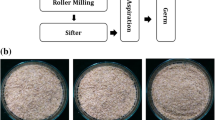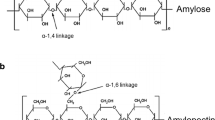Abstract
Evaluation of functional properties of milled fractions of grain amaranth may be useful to decide the end uses of the grain. Hence, pasting profiles of amaranth fractions obtained by milling the grains at different moisture contents were studied in relation with their starch profile and also with their swelling power and solubility indices. It was observed that, for flour fraction, the viscosity parameters were lowest at 14–16 % moisture content. Swelling power and solubility indices of the samples varied as a function of grain moisture content. The middling fraction also showed similar pasting pattern with the variation of grain moisture content. The seed coat fractions showed higher gelatinization temperature compared to that of fine flour and middling fractions. However, starch content of the fine seed coat fraction was comparable with that of the flour and middling fractions. The coarse seed coat fraction showed lower viscosity parameters than the other samples. Viscosity parameters correlated well among themselves while, they did not show significant correlation with the starch content. However, the viscosity parameters showed negative correlation with the soluble amylose content. The study revealed that, the fractions obtained by milling the grains at different moisture content show differential pasting profiles and functional properties.
Similar content being viewed by others
References
AACC (2000) Approved methods of the American Association of cereal Chemists, 10th edn. St Paul, American Association of Cereal Chemists
Adebowale KO, Afolabi TA, Olu-Owolabi BI (2005) Hydrothermal treatments of finger millet (Eleusine coracana) starch. Food Hydrocoll 19:974–983
Alvarez-Jubete L, Arendt EK, Gallagher E (2009) Nutritive value and chemical composition of pseudocereals as gluten-free ingredients. Int J Food Sci Nutr 60(S4):240–257
Baker LA, Rayas-Duarte (1998) Freeze-Thaw stability of amaranth starch and the effects of salts and sugars. J Cereal Chem 75(3):301–307
Becker R, Wheeler EL, Lorenz K, Stafford AE, Grosjean OK, Betscgart AA, Saunders RM (1981) A compositional study of amaranth grain. J Food Sci 46:1175
Bello-Perez LA, Garacia-Suarez FJ, Mendez-Montealvo G, do Nascimento O Jr, Maria Lajolo F, Cordenunsi BR (2006) Isolation and characterization of starch from seeds of Araucaria brasiliensis: a novel starch for application in food industry. Starch-Starke 58:283–291
Berghofer E, Schoenlechner R (2002) Grain amaranth. In: Belton P, Taylor J (eds) Pseudocereals and less common cereals. Springer, New York, pp. 219–260
Bressani (1989) The properties of grain amaranth. Food Rev Int 5(1):13–38
Chaturvedi A, Sarojini G, Nirmala G, Nirmalamma N, Satyanarayana D (1997) Glycemic index of grain amaranth, wheat and rice in NIDDM subjects. Plant Foods Hum Nutr 50:171–178
Dharmaraj U, Meera MS, Yella Reddy S, Malleshi NG (2015) Influence of hydrothermal processing on the functional properties and microstructure of finger millet. J Food Sci Technol 52(3):1361–1371
Escudero NL, Zirulnik F, Gomez NN, Mucciarelli SI, Gimenez MS (2006) Influence of protein concentrate from Amaranthus cruentus seeds on lipid metabolism. Exp Bio Med 231:50–59
Haros M, Perez OE, Rosell CM (2004) Effect of steeping corn with lactic acid on starch properties. Cereal Chem 81(1):10–14
Holm J, Bjorck I, Drews A, Asp NG (1986) A rapid method for the analysis of starch. Starch/Starke 38:224–226
Ikegwu OJ, Nwobasi VN, Odoh MO, Oledinma NU (2009) Evaluation of the pasting and some functional properties of starch isolated from some improved cassava varieties in Nigeria. Afr J Biotechnol 8(10):2310–2315
Kaur S, Singh N, Rana JC (2010) Amaranthus hypochondriacus and amaranthus caudatus germplasm: characteristics of plants, grain and flours. Food Chem 123:1227–1234
Kong X, Kasapis S, BertoftE CH (2010) Rheological properties of starches from grain amaranthand their relationship to starch structure. Starch-Starke 62:302–308
Leach HW, Mccowen LD, Schoch TJ (1959) Structure of the starchgranules I. Swelling and solubility patterns of various starches. Cereal Chem 36:534–541
Mendonca S, Saldiva PH, Cruz RJ, Areas JAG (2009) Amaranth protein presents cholesterol-lowering effect. Food Chem 116(3):738–742
Nanka, G. 1998. Herstellung und charakterisierung von mahlproduktenaus pseudo-cerealien. Dissertation, University of Agricultural Sciuence, Vienna.
Oguntunde AO (1987) Review: starch modification for food application. Nigeri Food J 5:102–107
Resio AC, Suarez C (2001) Gelatinization kinetics of amaranth starch. Int J Food Sci Technol 36(4):441–448
Sakhare SD, Aashitosh AI, Shwetha B, Gaikwad ID, Vekateswara Rao G (2014) Roller milling fractionation of green gram (Vigna radiata): optimization of milling conditions and chemical characterization of millstreams. J Food Sci Technol 51(12):3854–3861
Sakhare SD, Aashiosh AI, Prabhasankar P (2015) Roller milling process for fractionation of fenugreek seeds and characterization of milled fractions. J Food Sci Technol 52(4):2211–2219
Sanni LO, Ikuomola DP, Sanni SA (2001) Effect of length of fermentation and varieties on the qualities of sweet potato gari. Proc.8th triennial Symposium of the International Society for Tropical Root Crops. Africa Branch (ISTRC-AB), Ed. M.O. Akoroda, IITA, Ibadan, Nigeria, 12–16 November 2001, pp. 208–211
Schoenlechner R (2000) Untersuchung der verarbeitungstechnischeneigenshaften und nutzungsmoglichkeiten der pseudoerealien amaranth und quinoa. University of Agricultural Science, Vienna, Austria, Dissertation
Shevkani K, Singh N, Kaur A, Rana JC (2014) Physicochemical, pasting and functional properties of amaranth seed flours: effects of lipids removal. J Food Sci 70(7):C1271–C1277
Shimelis AE, Meaza M, Rakshit S (2006) Physico-chemical properties, pasting behaviour and functional characteristics of flours and starches from improved Bean (Phaseolus Vulgaris L.) varieties. grown in East Africa. CIGRE J 8:1–18
Singh S, Kaur S, Kaur A, Isono N, Ichihashi Y, Noda T (2014) Structural, thermal and rheological properties of amaranthus hypochondriacus and amaranthus caudatus starches. Starch-Starke 66:457–467
Sowbhagya CM, Bhattacharya KR (1971) A simplified colorimetric method for determination of amylose content in rice. Starch 23(2):53–56
Stone LA, Lorenz K (1984) The starch of Amaranthus-Physicochemical properties and functional characteristics. Starch 36:232–237
Teli MD, Shanbag V, Dhande SS, Singhal RS (2007) Rheological properties of Amaranthus paniculates (Rajgeera) starch vis-à-vis Maize starch. Carbohydr Polym 69(1):116–122
Teutonico A, Knorr RD (1985) Amaranth: Compositions, properties and applications of a rediscovered food crop. Ecological agricultural projects. McGill University, Canada http://eap.mcgill.ca/CPAT_1.htm
Wu HX, Corke H (1999) Genetic diversity in physical properties of starch from a world collection of Amaranthus. Cereal Chem 76:877–883
Acknowledgments
The authors acknowledge with thanks the support and encouragement received from Director, CSIR-CFTRI, Mysore, India.
Author information
Authors and Affiliations
Corresponding author
Rights and permissions
About this article
Cite this article
Kumar, K.V.P., Dharmaraj, U., Sakhare, S.D. et al. Effect of grain moisture content during milling on pasting profile and functional properties of amaranth fractions. J Food Sci Technol 53, 2434–2442 (2016). https://doi.org/10.1007/s13197-016-2226-8
Revised:
Accepted:
Published:
Issue Date:
DOI: https://doi.org/10.1007/s13197-016-2226-8




